|
|
One of the reasons for a blog is to have a log of things that I’ve done or occurred in the past. Comparing the spring of 2013 to the spring of 2012, here in Central Maryland, one will notice two completely different late winter/spring weather outcomes. The winter/spring of 2012 was warmer than this year. The average daily temperature for the time period from mid-February through mid-March was ten degrees colder in 2013 than it was in 2012. A year ago I recall that flowering trees were in full blossom in mid-March; this year that event was a month later.
My grape vines tend to follow the spring flowering trees. They are beginning to show signs that they are still alive, although it is a month later than last year. How will this fair during harvest? The vines seem to be on the same schedule they were in 2011. If so, harvest should be the beginning of September. Of course 2011 was the year we lost everything due to the remnants of a hurricane then a rain train that dumped double digits of rain on us for days on end. But that was the past. As the grape vines bud and spring forth, so does optimism. There is that hope to make another batch of wine from our grapes.
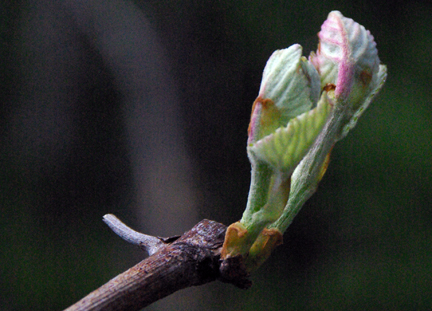 Niagara vine just began leafing this week.
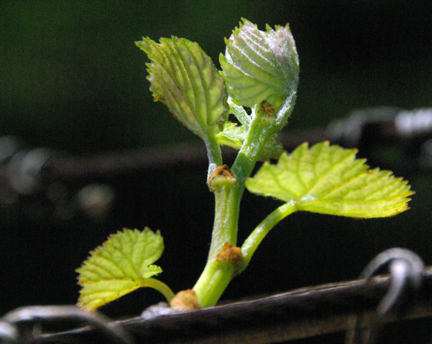 Petit Manseng a bit further ahead of the Niagara. Cheers,
Terry
On our recent trip to Croatia for the International Wine Tourism Conference we visited ten wineries. At the wineries we visited, we spoke with someone that could speak English. Most of the time it was the winemaker. On a few visits, the winemaker was a little apprehensive about their ability to speak English. I noticed that when the conversation was about winemaking though, their English improved quite a bit.
We were tasting wines at San Tommaso in Bale in the Istria wine region. The winemaker was a little apprehensive. Then I began talking about the wines that Kathy and I have made. I mentioned a white Cabernet Sauvignon. Janja Debeljuh, owner and winemaker, sprang up from her chair and rushed into the production area. She returned with her white Cabernet Sauvignon. It was an orange translucent color and had aromas and tastes of red berry fruit. After our discussion of white Cab, Janja’s English seemed to be much better.
Perhaps winemaking talk improves one’s ability to community with other winemakers. We have discovered that when we talk about our winemaking experiences, many winemakers are much more at ease with us. They see us as fellow winemakers and not as writers. So far we experience this wherever we travel. A test will be this summer when we travel to Champagne, Burgundy and Bordeaux. We are going to visit the regions with a group of winemakers and wine growers. This trip was arranged by Washington State University. I’m anxious to see how the French winemakers will interact with other winemakers and growers. There are language barriers, but talking about winemaking bridges some of those obstacles and allows for communication.
Cheers,
Terry
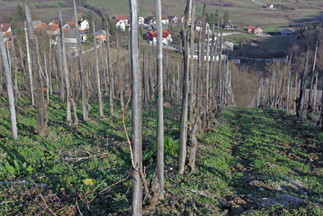 Now that we are in Croatia visiting wineries, we’ve come across some different terms than those used previously. Grape varieties such as Riesling, Chardonnay and Cabernet Sauvignon, amongst others, are referred to as International varieties. Previously I would refer to these as French vinifera, but I like the term international varieties because these grapes truly are grown internationally. It just makes sense. The other term that I am beginning to get use to is wineyard. For years I’ve used the term vineyard, but wineyard also makes sense. Actually the longer I’m in Croatia the more I like the term. Now that we are in Croatia visiting wineries, we’ve come across some different terms than those used previously. Grape varieties such as Riesling, Chardonnay and Cabernet Sauvignon, amongst others, are referred to as International varieties. Previously I would refer to these as French vinifera, but I like the term international varieties because these grapes truly are grown internationally. It just makes sense. The other term that I am beginning to get use to is wineyard. For years I’ve used the term vineyard, but wineyard also makes sense. Actually the longer I’m in Croatia the more I like the term.
Yesterday we explored two wineries to the west of Zagreb. We noticed an interesting system in some of the wineyards. Although some had traditional trellising systems, others had vines staked. A single pointed stake was placed next to each vine and no wires were used to connect the vines. At Ciban Winery, Dragec and Irena Ciban mentioned that the staked vines were planted in 1898. There are more than thirty varieties many of which have not beed identified.
Another interesting change of terms is black wine instead of red wine. The wines we had yesterday were closer to black in color than red, so this is another example of a term that makes sense. World travel offers chances to learn about wine making and wine growing as seen through different eyes. We are in Croatia to learn about their winemaking and to attend and present at the International Wine Tourism Conference in Zagreb on March 15th and 16th.
Cheers,
Terry
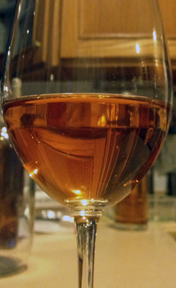 It smells like wine. We must have done something correct. A couple small carboys, in the refrigerator for a few months, were filled with a white Cabernet Sauvignon. Meanwhile a couple larger carboys with another white Cabernet Sauvignon needed racking. So it was time to move things around. Starting with the refrigerated carboys of wine, they were removed and allowed to warm up to room temperature. Then we filtered the wine and bottled it. Of course we had a bit extra. It smells like wine. We must have done something correct. A couple small carboys, in the refrigerator for a few months, were filled with a white Cabernet Sauvignon. Meanwhile a couple larger carboys with another white Cabernet Sauvignon needed racking. So it was time to move things around. Starting with the refrigerated carboys of wine, they were removed and allowed to warm up to room temperature. Then we filtered the wine and bottled it. Of course we had a bit extra.
The white Cabernet Sauvignon is an orange color. Quite a contrast to the dark ruby to almost black color I get making my usual Cabernet Sauvignon. The wine offered a different tasting profile. The aroma and taste reminded me of berries. The mouthfeel was quite smooth and there was a hint of apple and peach on the aftertaste. This is a Cabernet Sauvignon? There may be a slight hint of tannins if you hunt for them. The juice for this wine did see about thirty minutes of skin contact. Grapes for this white Cabernet Sauvignon were from Virginia.
The orange color is growing on me. I seem to like it better the more I stare at it.
Cheers,
Terry
I would like to thank those who attended the session M01: Turning Customers into Brand Ambassadors at the Eastern Winery Exposition. I wish we had time for questions and answers. There are many additional things, than those mentioned, that wineries can do to cultivate brand ambassadors. My wife, Kathy, and I are presenting a much longer session on Cultivating Brand Ambassadors at the International Wine Tourism Conference next week in Zagreb, Croatia. The session will include some very specific things that can be done that make the winery experience exceptional. You may be interested in an interview with IWINETC that discusses the difference between customers and brand ambassadors, the amount of work it takes to cultivate brand ambassadors and how you know when you have created brand ambassadors. Check the link to the interview.
The Eastern Winery Exposition is making our PowerPoint presentations available to attendees. I’ll post a link when it is posted on their site. Likewise, near the end of March, I’ll post a link to my presentation in Zagreb.
Cheers,
Terry
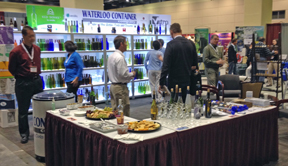 2013 Eastern Winery Exposition Trade Show On Thursday, the day after Terry’s presentation at the Eastern Winery Exposition, in Lancaster Pennsylvania, we attended the trade show. The exhibit was designed with winemakers, winery owners, viticulturists and tasting room managers in mind.
Winemakers may be interested in the variety of oak barrels available. Or at the high cost of a traditional oak barrel they might want to look at the display by Wine Stix. This company offers a selection of oak staves, tethers and segments, all available at four toast levels. Bottling equipment from small hand items to a bottling line were available to browse. Several closure companies including cork companies displayed their types of wine bottle closures. We stopped at Reliable Cork Solutions to learn about their SlimCork line. We also stopped at the Nomacorc display and visited with one of the representatives, Whitney Rigsbee, whom we met earlier at the 2012 Wine Bloggers Conference in Portland, Oregon.
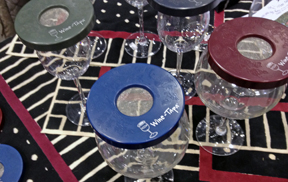 2013 Eastern Winery Exposition Trade Show Vineyardists will want to look at the numerous companies offering pruning and netting products. We commented on the display of pneumatic pruning shears that looked potentially finger threatening but it sure would make pruning easy. One company offered deer netting solutions; others had bird netting.
Tasting room managers would find an array of giftware to add to their tasting room. Items include wine charms, shirts, and numerous other items. One of the more interesting ideas was The Wine-Tapa, a wineglass cover designed to keep fruit flies out of your glass.
For those interested in learning more about winemaking, Enology & Viticulture Programs Central Pennsylvania’s Community College provided information on their options.
Trade shows that occur across the country provide, winemakers with the opportunity to view products talk with representatives all gathered together in one place.
Cheers,
Kathy
This is the second year for the Eastern Winery Exposition and the first year I attended. According to Richard Leahy, Conference Manager, in just two years the conference has grown to become the second largest wine and trade show conference in the country. On Tuesday evening, a wine reception was held. Many of the winemakers brought wines to the reception. The atmosphere was jovial, lots of people were having fun tasting wines, reacquainting with friends and munching on the foods.
The first day of sessions started early at 8:15 am. I attended a session called Avoiding Oxidation in Small Wineries presented by Tom Payette. Tom’s manner of presenting was easy going and quite understandable by experienced winemakers and beginners. The second session focused on Lab Trials for Fining Agents presented by Peter Bell and Tom Payette. Both presenters were easy to follow and offered great advice on fining wines including broadening the definition of fining to include acid additions or subtractions. The third session looked at When and Why You Do Wine Analyses by Dr. Barry Gump. Dr. Gump also had an easy going presentation. During the presentation, a slide that showed the traditional way to use a hydrometer was quickly overturned by the speaker. One does not need a cylinder twice the width of the hydrometer, said Dr. Gump, just slightly larger than the diameter of the hydrometer will suffice. Dr. Gump also pointed out that some analyses of wine is meant for research purposes and has little bearing on making the wine and selling it.
We had lunch in one of the ballrooms, offering an opportunity to sit down and chat with people at your table. During the afternoon, I joined a panel and presented my talk on Turning Customers into Brand Ambassadors. Also on the panel was Patty Held from Missouri and Brian Roeder from Virginia. We definitely needed more time for our panel presentation and had no time to field questions. The next presentation was also a panel that looked at Social Media for Winemaking. Patty Held, Kris Chislet and Laurie Forster all gave the attendees much to think about. Something that I took from the presentation is the possibility to create a mobile version of our website and perhaps create an app. The app idea sounds intriguing and I already have several topics for apps.
During the evening we had a lovely dinner in a ballroom. The Second Annual Eastern Winery Exposition Industry Celebration Dinner was a nice end to a busy day. Laurie Foster spoke to the diners with her comedy act. Winemaker and owner of Presque Isle Wine Cellars, Doug Moorhead received the 2013 Lifetime Achievement Award.
On our next day, it is on to the trade show.
Cheers,
Terry
I attended a session at the Eastern Winery Exposition titled Avoiding Oxidation in Small Wineries. Tom Payette was the presenter and used PowerPoint slides during the presentation. He mentioned several variables that influence oxygen reacting with the wine. Some variables can be controlled while other can not. Tom was especially wary of the use of variable capacity tanks, a popular type of tank used in many small wineries. Most of the problems he was called on to investigate and help with were due to variable capacity tanks. For the short term, these tanks are great. For the long term storage they present challenges for the winemaker. Tom mentioned the importance of controlling the surface area in carboys, barrels and tanks. Topping off gases are a temporary solution to helping reduce oxidation; however, they are not as good as a full tank.
The oxidation challenge is not all doom and gloom. There are some producers that want to create oxidized wines and have a market for them. At some points in the winemaking process, oxygen is a good thing. During fermentation, oxygen is a nutrient for yeasts. In aging, oxygen can soften tannins.
The winemaker can check hoses to see if there are leaks, and reduce the container’s surface area where oxygen can contact the wine. Winemakers should also be cognizant of the potential for wines to become oxidized at different parts of the winemaking process.
Cheers,
Terry
Vintners crafting a 2012 wine at Tin Lizzie Wineworks in Howard County, Maryland spent Saturday and Sunday racking their wine from one barrel to another. I decided to check the progress of my Atlas Peak AVA Cabernet Sauvignon. Prior to putting the wine in a Taransaud barrel last November, the wine exhibited a bit of herbal and vegetative nuances on the aroma and taste. When I tasted the wine on Saturday, gone were the herbal and vegetative hints that I picked up four months ago. The wine has some influence from the oak, but at the moment it is more subtle than “in your face.” For only four months in French oak, the wine had a wow factor.
Dave Zuchero, head winemaker, gave me a challenge to decide to rack or not rack my wine. After some research, I decided that I’d let the wine age for several more months sur lees. I want the wine to be complex, and many winemakers like the aging on the lees. I did stir the wine while in the barrel so the wine could access the oak under the lees. At the moment of tasting the wine on Saturday, prior to stirring it, I was impressed with its maturity. This wine may represent a vintage year for Napa Valley and 2012 may just be one of the best in the last several years. I’m glad to have a barrel of it.
Cheers,
Terry
Wine that can age continues to surprise. Last night we had dinner with family at The Hill in Grosse Point. My brother likes this restaurant in part because he can bring his own wine to the restaurant. While in his cellar I spied a bottle of the 2009 Illuminatus Cabernet Sauvignon/Merlot that Kathy and I made at Tin Lizzie Wineworks in Maryland. It has been quite awhile since I tried this predominantly cab, so I was interested in seeing how it was after being in bottle for two and a half years.
Wow! this wine has improved a great deal. Over the past couple years the American oak influences were overwhelming taking an in your face attitude. Now the influence of the oak was subdued, allowing the fruit a chance to shine. The wine is now wonderfully drinkable and it will be interesting to see how it continues to mature over the years. However, I only have six bottles left and my brother has about a case left.
There is a problem with aging wines. My brother likes to point out that If you drink it, it is gone. If you don’t drink it, you might be gone. As a winemaker, I find it necessary to try the wine, just to see how it is doing. It is similar to keeping track of your childrens’ grades. This urge to try the wine is why I only have six bottles left. As I make more wines that have aging potential, I may learn the skill of patience and refrain from opening them on a regular basis.
I am thrilled that this cab is turning out to be a great wine. Kathy and I have a barrel of California Cab at Tin Lizzie aging. We hope to leave it in barrel a couple years or longer. I now have a better understanding that I’ll need to leave it in bottle for a few years without trying it every month. Discovering what aging can do to an ageable wine is a great addition to our wine journey.
Cheers,
Terry
|
|









Winemaking Helps Break the Language Barrier
On our recent trip to Croatia for the International Wine Tourism Conference we visited ten wineries. At the wineries we visited, we spoke with someone that could speak English. Most of the time it was the winemaker. On a few visits, the winemaker was a little apprehensive about their ability to speak English. I noticed that when the conversation was about winemaking though, their English improved quite a bit.
We were tasting wines at San Tommaso in Bale in the Istria wine region. The winemaker was a little apprehensive. Then I began talking about the wines that Kathy and I have made. I mentioned a white Cabernet Sauvignon. Janja Debeljuh, owner and winemaker, sprang up from her chair and rushed into the production area. She returned with her white Cabernet Sauvignon. It was an orange translucent color and had aromas and tastes of red berry fruit. After our discussion of white Cab, Janja’s English seemed to be much better.
Perhaps winemaking talk improves one’s ability to community with other winemakers. We have discovered that when we talk about our winemaking experiences, many winemakers are much more at ease with us. They see us as fellow winemakers and not as writers. So far we experience this wherever we travel. A test will be this summer when we travel to Champagne, Burgundy and Bordeaux. We are going to visit the regions with a group of winemakers and wine growers. This trip was arranged by Washington State University. I’m anxious to see how the French winemakers will interact with other winemakers and growers. There are language barriers, but talking about winemaking bridges some of those obstacles and allows for communication.
Cheers,
Terry